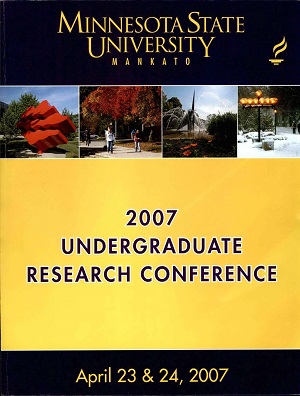Fiuoroquinalone Antibiotics and Cadmium Mobilities in Soil Environments
Location
CSU 253/4/5
Start Date
23-4-2007 1:00 PM
End Date
23-4-2007 3:00 PM
Student's Major
Chemistry and Geology
Student's College
Science, Engineering and Technology
Mentor's Name
Trent Vorlicek
Mentor's Department
Chemistry and Geology
Mentor's College
Science, Engineering and Technology
Description
Human and livestock wastes are often applied to agricultural fields as fertilizers. These wastes may contain up to mg-kg"^ concentrations of antibiotics and potentially toxic metals (e.g., Cd, Pb, Zn, Cu, Ni). The impact of these components on public health requires a thorough knowledge of their fate and transport in soil systems. Several common antibiotics, including the fluoroquinolone and quinolone classes, are known to readily complex divalent metals commonly leached from human and animal wastes. These interactions may affect the mobility of metals by influencing the partitioning between metals in aqueous and sorbed phases. The common clay minerals, illite and kaolinite were chosen for comparison in this study because of their abundance in soil systems and difference in cation exchange capacities. Test slurries were prepared to study the uptake of several metals (e.g., Cd, Pb, Cu) in the presence and absence of varying concentrations of antibiotics (e.g., ciprofloxacin, norfloxacin, oxolinic acid, nalidixic acid) at near groundwater pH and constant ionic strength using a p-nitrophenol buffer. Preliminary data indicates Cd readily adsorbs to both illite and kaolinite in the presence of antibiotics. Research including the addition of variable concentrations of antibiotics to Cd containing slurries is ongoing.
Fiuoroquinalone Antibiotics and Cadmium Mobilities in Soil Environments
CSU 253/4/5
Human and livestock wastes are often applied to agricultural fields as fertilizers. These wastes may contain up to mg-kg"^ concentrations of antibiotics and potentially toxic metals (e.g., Cd, Pb, Zn, Cu, Ni). The impact of these components on public health requires a thorough knowledge of their fate and transport in soil systems. Several common antibiotics, including the fluoroquinolone and quinolone classes, are known to readily complex divalent metals commonly leached from human and animal wastes. These interactions may affect the mobility of metals by influencing the partitioning between metals in aqueous and sorbed phases. The common clay minerals, illite and kaolinite were chosen for comparison in this study because of their abundance in soil systems and difference in cation exchange capacities. Test slurries were prepared to study the uptake of several metals (e.g., Cd, Pb, Cu) in the presence and absence of varying concentrations of antibiotics (e.g., ciprofloxacin, norfloxacin, oxolinic acid, nalidixic acid) at near groundwater pH and constant ionic strength using a p-nitrophenol buffer. Preliminary data indicates Cd readily adsorbs to both illite and kaolinite in the presence of antibiotics. Research including the addition of variable concentrations of antibiotics to Cd containing slurries is ongoing.
Recommended Citation
Danberry, Aaron L.. "Fiuoroquinalone Antibiotics and Cadmium Mobilities in Soil Environments." Undergraduate Research Symposium, Mankato, MN, April 23, 2007.
https://cornerstone.lib.mnsu.edu/urs/2007/poster-session-B/2



